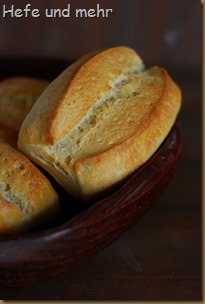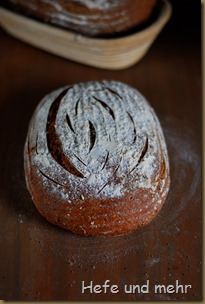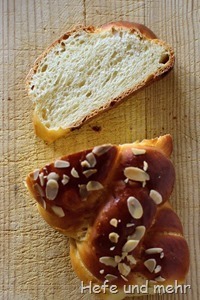 Some time ago I showed this braids already while they cooled down on sunday morning. I promised to post the recipe, if they turned out nicely – and they did! So here it is. It is mainly a “use leftovers” recipe as it contains a bit of left over quark and some sweet starter after refreshing. The Quark adds a nice moistness to the dough and enhances shelf live. But the special turn in this recipe is the tiny bit of rye flour I added. As I learned last year from the Onjeschwedde is a small dose of rye good to enhance the crumb structure to extra soft and pillowy.
Some time ago I showed this braids already while they cooled down on sunday morning. I promised to post the recipe, if they turned out nicely – and they did! So here it is. It is mainly a “use leftovers” recipe as it contains a bit of left over quark and some sweet starter after refreshing. The Quark adds a nice moistness to the dough and enhances shelf live. But the special turn in this recipe is the tiny bit of rye flour I added. As I learned last year from the Onjeschwedde is a small dose of rye good to enhance the crumb structure to extra soft and pillowy.
Another point I love at weekends too is the fact that the recipe is great for proofing overníght in the fridge. So the next morning the only thing I had to do is placing the baking tray in the oven. Perfect for relaxed sundays!

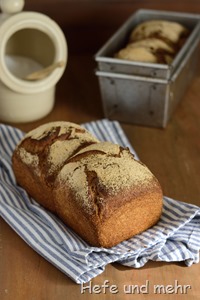 Inspiration is a strange thing: there are phases with only few ideas and then there are phase when my mind is so full that I nearly don’t know which bread I should bake first. At the moment I have so many recipe drafts waiting to a test bake. And then comes a new recipe idea from a reader and sometimes I like the idea so much that it overtakes them all.
Inspiration is a strange thing: there are phases with only few ideas and then there are phase when my mind is so full that I nearly don’t know which bread I should bake first. At the moment I have so many recipe drafts waiting to a test bake. And then comes a new recipe idea from a reader and sometimes I like the idea so much that it overtakes them all.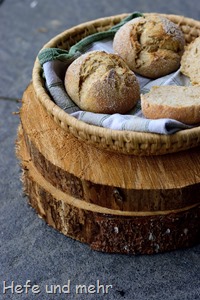 Sometimes it is just time to use leftovers. Like last friday, when I looked around in the kitchen: there was some leftover fine rye meal from the blackbread, a small bowl with mashed potatoes and in the fridge I found a lonely egg yolk. And so I combined everything and kneaded a dough for the next day. As I prefer freshly baked rolls for breakfast, the dough rose overnight in the fridge.
Sometimes it is just time to use leftovers. Like last friday, when I looked around in the kitchen: there was some leftover fine rye meal from the blackbread, a small bowl with mashed potatoes and in the fridge I found a lonely egg yolk. And so I combined everything and kneaded a dough for the next day. As I prefer freshly baked rolls for breakfast, the dough rose overnight in the fridge.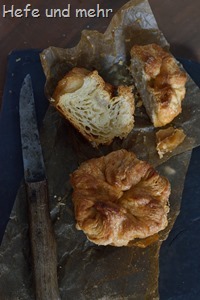 Butter is a staple in the Breton kitchen – which shows in the
Butter is a staple in the Breton kitchen – which shows in the  Kieler Semmeln are rolls which stem – as their name suggested – from Kiel. They are a special roll as they are rubbed in a mixture of butter and salt, which gives their surface a rough look and adds a nice buttery and sligthly salty flavour. There are different recipes around for this kind of rolls, some of the containing lard or cinnamon as well. Cinnamon seems to me a bit to adventurous for a first trial, but I keep this variant in the back of my head for a second version.
Kieler Semmeln are rolls which stem – as their name suggested – from Kiel. They are a special roll as they are rubbed in a mixture of butter and salt, which gives their surface a rough look and adds a nice buttery and sligthly salty flavour. There are different recipes around for this kind of rolls, some of the containing lard or cinnamon as well. Cinnamon seems to me a bit to adventurous for a first trial, but I keep this variant in the back of my head for a second version.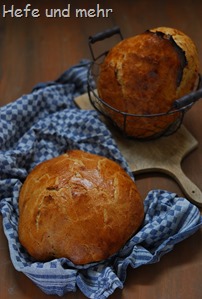 “Eingenetztes Brot” would be Net-Bread if translated literally. But the origin from the word “eingenetzt” does not stem from the German “Netz” (net) but from “Nass”, which means “Wet”. And making the bread is wet indeed. The sticky dough is easiest to handle when hands and tools are really wet. When the bread is placed in the oven its surface is wet as well. This helps to create the shiny crust which is characteristic for this bread. To get the soft dough in the oven without accident, a so called “Schapf”, a kind of ladle, is used traditionally. Even in my rather big kitchen collection, there is no “Schapf” and so I used a small salad bowl instead. And this worked fine!
“Eingenetztes Brot” would be Net-Bread if translated literally. But the origin from the word “eingenetzt” does not stem from the German “Netz” (net) but from “Nass”, which means “Wet”. And making the bread is wet indeed. The sticky dough is easiest to handle when hands and tools are really wet. When the bread is placed in the oven its surface is wet as well. This helps to create the shiny crust which is characteristic for this bread. To get the soft dough in the oven without accident, a so called “Schapf”, a kind of ladle, is used traditionally. Even in my rather big kitchen collection, there is no “Schapf” and so I used a small salad bowl instead. And this worked fine!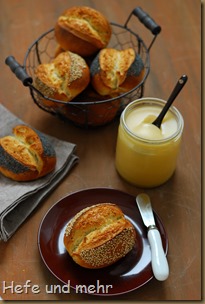 To me, the basic of good breakfast is a good roll. And so we are baking rolls in part three of our little bread baking course. These rolls are looking more complicated then they. For shaping we will use the same method then for the bread we baked last time. And already after 15 minutes the rolls are deeply cut, which is much easier than cutting a fully proofed roll. The cut is carefully laid together and will open beautiful during baking.
To me, the basic of good breakfast is a good roll. And so we are baking rolls in part three of our little bread baking course. These rolls are looking more complicated then they. For shaping we will use the same method then for the bread we baked last time. And already after 15 minutes the rolls are deeply cut, which is much easier than cutting a fully proofed roll. The cut is carefully laid together and will open beautiful during baking.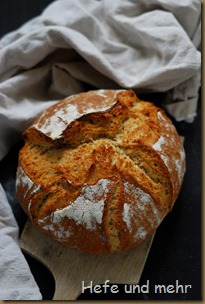 I got a lot of positive feedback to my idea of making a small virtual bread baking course. I’m very happy about it and will start to post more beginner recipes on the blog in the next weeks. And if you have questions, ideas or wishes: Please tell me! I will do my best to include it.
I got a lot of positive feedback to my idea of making a small virtual bread baking course. I’m very happy about it and will start to post more beginner recipes on the blog in the next weeks. And if you have questions, ideas or wishes: Please tell me! I will do my best to include it.